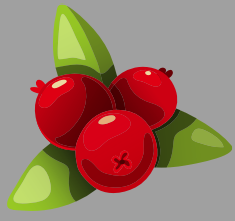Devyn LeBlanc
reporter@greenepublishing.com
Cranberries, they're tart and often pushed to the side in favor of sweeter berries such as strawberries and raspberries. During the winter holidays, however, the cranberry is a holiday staple baked into cookies, sweet breads and sauces.
Native Americans used cranberries as a staple as early as 1550. They ate cranberries fresh, ground or mashed with cornmeal and baked into bread. They also mixed cranberries with dried meat and animal fat to make a dish known as pemmican, that lasted for months and could be eaten during the winter. Maple sugar or honey was often used to sweeten this berry's tart and tangy flavor. Native Americans discovered the cranberry's versatility as a fabric dye and healing agent as well. They believed in the medicinal value of the cranberry, using it in poultices to draw poison from arrow wounds.
The United States Department of Agriculture (USDA) started a cranberry breeding program in 1929, with a few agriculture experiment stations. Some of the varieties and cultivars that are grown today came from that program. Early Black is a common variety of cranberry. They were discovered in 1835 but are still popular. Early Blacks are the first variety to ripen and be harvested. These sweet berries are small and dark red in color, almost black. McFarlin cranberries are a wild variety, discovered in the late 1800s, in Massachusetts. These berries range between medium and large in size, and have a dark red color. Pilgrim cranberries are a cross between McFarlin cranberries and a variety of others, and have been grown since 1961. These berries are large and juicy with a purplish-red color and a hint of yellow. Stevens cranberries are the most common variety grown in the United States, particularly in Oregon. Around 75 percent of Oregon’s cranberry acres are planted with Stevens. This variety of cranberry was introduced in 1950.
Throughout the 19th and 20th centuries, cranberries played a significant role in the economies of Massachusetts and its neighboring states. As farm equipment became more efficient, the hard labor of cranberry production and harvest became faster and easier. This led to the numbers of growers increasing to meet the heightened domestic and international demand for America's original berries.
A common misconception about cranberries is that they grow in huge water-filled bogs. Cranberries often grow on dry and sandy land. When the harvest season arrives in October and November, growers flood their farms with fresh water from flood water reservoirs. Huge machines are then used to comb through the water and skim off the fruit. Before the flooding period, farmers typically have a short dry-harvest, where they use a raking machine to pick the ripe berries off the vines.

